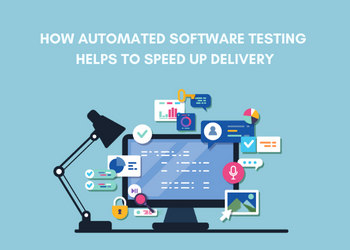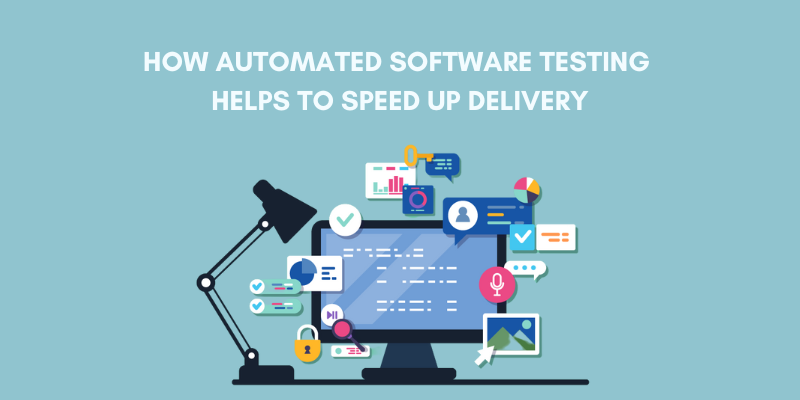How Automated Testing Speeds Up Delivery


Automation testing is not new to the software industry. Innovators have used automation to create more efficient, intelligent, and personalized software products, ranging from chatbots to data analysis solutions. Development teams have implemented internal automation to streamline critical aspects of the software development lifecycle (SDLC). For example, automated software testing simplifies repetitive, time-consuming, and laborious manual testing. Increasing the speed and accuracy of each test case reduces overall testing effort and cost.
This approach is discussed in depth in our quick guide to automated software testing and its importance in modern software delivery.
Read more: 9 Tips To Improve The Efficiency Of Software Testing
Manual Testing vs. Automated Testing Services
Manual software testing involves a tester running the application and verifying the results. Manual testers document any flaws they discover, determine the root cause of defects, recommend solutions, and validate fixes.
Automated testing involves executing test scripts using automated software testing tools. These tools run pre-recorded test cases or scripts specified by the user, automating much of the manual effort required for functional tests. Automated testing services can perform predefined tasks, compare results to expected behavior, and report the status. They can run single or multiple tests in a single environment and manage the lifecycle of automated tests, including data management, script creation, and test execution.
Read more: Different Types of Software Testing
How Automated Software Testing Helps to Speed Up Delivery
Automated Software Testing Yields Faster Feedback
Automated software testing provides immediate feedback, allowing teams to resolve issues before releasing code to production. Automation enables scripts to be run multiple times in succession and automatically starts tests when the developer checks in their code.
Automated Feedback at Code Check-In
Automation software captures a snapshot of the test environment before running tests. This snapshot records the current state of the test environment, tracking which tests were run, passed, or failed, and optionally stores the actual test results in a database or spreadsheet. Snapshots are also known as “test passes” or “test runs.” If something goes wrong, developers receive immediate feedback, allowing them to address the issue quickly. This is particularly useful in large teams, where developers can run all their tests before checking in their code, ensuring that no other developers have introduced new issues.
Allows Teams to Carry Out Testing Early in the SDLC
Typically, manual testing is performed after development is complete. This approach has two major drawbacks. First, waiting until development is complete requires the team to test the entire software all at once. Second, deferring testing until the end of development often results in a large backlog of issues for testers to address. Automated testing services enable teams to evaluate software earlier in the Software Development Life Cycle (SDLC), allowing them to identify and address issues sooner.
The integration of Development and Operations (DevOps) is key to testing earlier in the SDLC. The goal is to collaborate with DevOps teams to deliver high-quality software more quickly. Automated testing software can be integrated into the DevOps process, allowing DevOps tools to run tests automatically as part of the build and deployment process.
Automation Testing Reduces Delivery Bottlenecks
According to a GitLab study, software testing is often the most significant bottleneck in software delivery. These bottlenecks frequently cause delays as teams scramble to fix issues, which can lengthen the time to market or result in sparse releases as features are cut due to bugs.
Teams are often forced to revisit unclear or outdated tests, update test cases, and re-run them due to tester inconsistency. When testing needs to scale to meet the growth of a software product, manual testing becomes inefficient because each tester is limited by their bandwidth.
Automation simplifies testing by providing consistency and precision. Unlike humans, machines require specific and detailed test cases, which leads to more consistent and exact testing. Automation also allows teams to scale their testing efforts effectively. They can add an unlimited number of tests and run them in parallel without needing to hire additional personnel.
Moreover, automation enables tests to be run repeatedly, providing early and frequent feedback throughout the Software Development Life Cycle (SDLC). This continuous feedback helps teams address issues before delivery, reducing the risk of a bottleneck caused by bugs.
Automated Software Testing Allows for Better Test Coverage
Software test coverage is the percentage of a program’s code that is executed by one or more tests. The more code that is tested, the less likely it is that the program will contain errors. Automation testing allows for more granular and comprehensive testing compared to manual testing. Additional types of automated testing include:
- Functional Testing: This type of testing verifies the functionality of a software application by utilizing its user interface. It ensures that the software behaves as expected from the user’s perspective.
- Unit Testing: Unit testing examines the functionality or code within individual units, modules, or methods. It can be applied to a single class at a time or to multiple classes with different input parameters. For example, if a method is used to calculate the total cost of a purchase order, it might be called several times with different arguments in a unit test. If any call fails, both the test and the code have failed.
- Integration Testing: Integration testing ensures that all components of the system work together correctly. It is more complex than unit and functional testing and may involve multiple components. Integration testing is an ongoing process because the integration of new features can impact the existing system.
By incorporating these various types of automated testing, teams can achieve more comprehensive test coverage and ensure that all aspects of their software are thoroughly evaluated.
Why Choose Bestarion as Your Software Testing Partner
Bestarion, a leading software development and consulting firm, has many years of experience in providing outsourcing software testing services. We can provide your organization with the appropriate test environment and test automation tools to ensure that you deliver the highest quality software products to the market.
Bestarion evaluates your existing platform and collaborates with you to create a custom automation strategy using agile methodology and proven, best-in-class test automation tools.
Our software testing experts help pave the way for faster product releases by leveraging automation earlier in the delivery cycle.
Read more:
